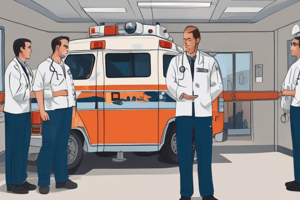Podcast
Questions and Answers
All of the following are examples of standard patient transfer equipment, EXCEPT:
All of the following are examples of standard patient transfer equipment, EXCEPT:
- Stokes baskets (correct)
- Long backboards
- Wheeled stair chairs
- Wheeled ambulance stretchers
What is the primary purpose of a 'jump kit'?
What is the primary purpose of a 'jump kit'?
Have available all of the equipment that will be used in the first 5 minutes.
What is the MOST important information to obtain from the dispatcher for an unresponsive patient?
What is the MOST important information to obtain from the dispatcher for an unresponsive patient?
The exact physical location of the patient.
What is the MOST important safety precaution when en route to a major motor vehicle collision?
What is the MOST important safety precaution when en route to a major motor vehicle collision?
Which of the following is NOT a guideline for safe ambulance driving?
Which of the following is NOT a guideline for safe ambulance driving?
At what speed will the ambulance begin to hydroplane when there is water present on the roadway?
At what speed will the ambulance begin to hydroplane when there is water present on the roadway?
Where do the most common and serious ambulance crashes occur?
Where do the most common and serious ambulance crashes occur?
What are the recommended dimensions for a helicopter landing zone?
What are the recommended dimensions for a helicopter landing zone?
Which of the following statements about helicopters is true?
Which of the following statements about helicopters is true?
Where should you park the ambulance upon arrival at a scene where hazardous materials are involved?
Where should you park the ambulance upon arrival at a scene where hazardous materials are involved?
Flashcards are hidden until you start studying
Study Notes
Patient Transfer Equipment
- Stokes baskets are not examples of standard patient transfer equipment.
- Common equipment includes long backboards, wheeled stair chairs, and wheeled ambulance stretchers.
Jump Kit Purpose
- A jump kit contains all equipment needed for the first 5 minutes of patient management.
- Ensures immediate access to essential tools like the AED is not the primary purpose.
Unresponsive Patient Call
- The exact physical location of the patient is the most crucial information to obtain from the dispatcher.
- Understanding the patient's condition and breathing status is vital but secondary to location.
Safety Precautions En Route
- Wearing seat belts and shoulder harnesses is the top priority for safety during transport to a major incident.
- Using lights and sirens is important, but situational awareness is equally critical.
Ambulance Driving Guidelines
- Guidelines state always exercise due regard for persons and property.
- It is not necessary to use one-way streets whenever possible or to always activate sirens with lights.
Hydroplaning Speed
- An ambulance will begin to hydroplane at 30 mph on wet roads.
- Awareness of speed limits and conditions is critical to avoid losing vehicle control.
Common Ambulance Crashes
- Most serious ambulance crashes occur at intersections.
- Recognizing high-risk areas is essential for safe driving.
Helicopter Landing Zone
- Recommended dimensions for a helicopter landing zone are 100 × 100 feet.
- Ensuring adequate space is crucial for safe helicopter operations.
Helicopter Safety Facts
- Main rotor blades of helicopters may dip to within 4 feet of the ground, posing a risk.
- Approach helicopters from the uphill side if they land on a slope.
Hazardous Materials Scene Safety
- Ambulances should be parked upwind from scenes involving hazardous materials.
- This precaution reduces the risk of exposure to dangerous substances.
Studying That Suits You
Use AI to generate personalized quizzes and flashcards to suit your learning preferences.




